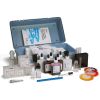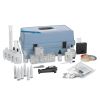Hach FF-3 Saltwater Aquaculture Test Kit
Features
- The digital titrator is a compact, accurate dispensing unit that replaces a buret
- Color disc features a continuous-gradient color wheel for fast, accurate comparisons
- All tests are stored in rugged carrying case
- Free ground shipping
- Expedited repair and warranty service
- Lifetime technical support
- More
Aquaculture has developed into a highly sophisticated field that uses scientific techniques to maintain the water where marine plants and animals live. The ability to optimize parameters affecting water quality is important for efficient production, and sensitive and accurate testing methods are essential.
The Hach saltwater aquaculture test kit is designed to meet this need. The kit includes chemicals and apparatus for the determination of 10 important water parameters and a rugged, armored thermometer for temperature readings. Packaged in a durable, portable case, the kit is well-suited for measurements in the field.
Acidity, alkalinity, carbon dioxide, dissolved oxygen, hardness, and salinity tests are conducted with the Digital Titrator - a compact, accurate dispensing unit that replaces a buret. Ammonia nitrogen, nitrite-nitrogen, and pH determinations are colorimetric tests. Results are obtained by matching the developed color of the sample to a pre-calibrated color disc.
With the Hach saltwater aquaculture test kit, the analyst can obtain the data necessary for making the right management decisions.
In The News
Save our Bogs! Culture, Conservation and Climate Action in Ireland’s Peatlands
Characterized by long-term accumulation under waterlogged conditions, peatlands exist on every continent and account for 3-4% of the global land surface . Small but mighty, these often overlooked wetland environments are estimated to hold as much as one-third of the world's organic carbon in their soil—twice the amount found in the entirety of the Earth's forest biomass. While healthy peatlands can trap and store carbon, regulate water, and provide important habitats for rare species, human alteration has disturbed peatland carbon and nitrogen cycles on a global scale. Approximately 12% of the world’s peatlands have been drained and degraded through conversion for agriculture, forestry, infrastructure development, and other uses.
Read MoreSargassum Surge: How Seaweed is Transforming our Oceans and Coastal Ecosystems
Until recently, Sargassum –a free-floating seaweed–was distributed throughout the Sargasso Sea , the north Caribbean Sea, and the Gulf of Mexico. But in the space of a decade, this seaweed has, as one scientist remarks , “Gone from a nonfactor to the source of a terrible crisis.” Driven by climate change, anomalous North Atlantic Oscillation in 2009-2010 and a glut of anthropogenic pollutants, sargassum has proliferated. Seasonally recurrent mats as deep as 7m now bloom in the “Great Atlantic Sargassum Belt” (GASB), which covers areas of the Atlantic from West Africa to the Caribbean Sea and Gulf of Mexico. Every year, millions of tons wash up along the shores of more than 30 countries . Dr.
Read MoreGreat Lakes Research Center: Designing Targeted Monitoring Solutions
According to the National Oceanic and Atmospheric Administration ( NOAA ), the Great Lakes have more miles of coastline than the contiguous Atlantic and Pacific coasts combined and contain 20 percent of the world's freshwater, making it a critical region to protect and conserve. Continuous monitoring and data-informed resource management are key components of managing waters in the region. Hayden Henderson, a research engineer with the Great Lakes Research Center (GLRC), designs and deploys monitoring platforms throughout the Great Lakes. With a background in environmental engineering, Henderson enjoyed the challenge of creating systems and making them work to obtain difficult, remote measurements.
Read More








